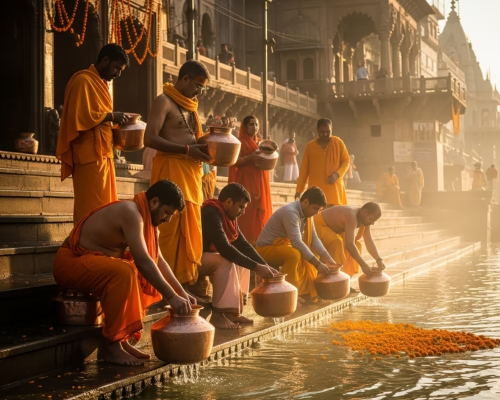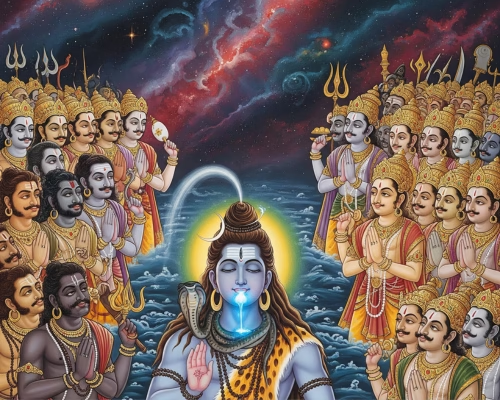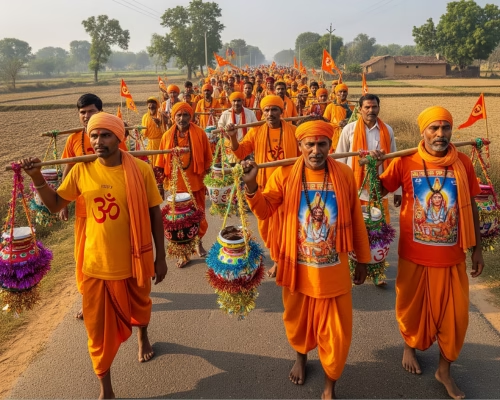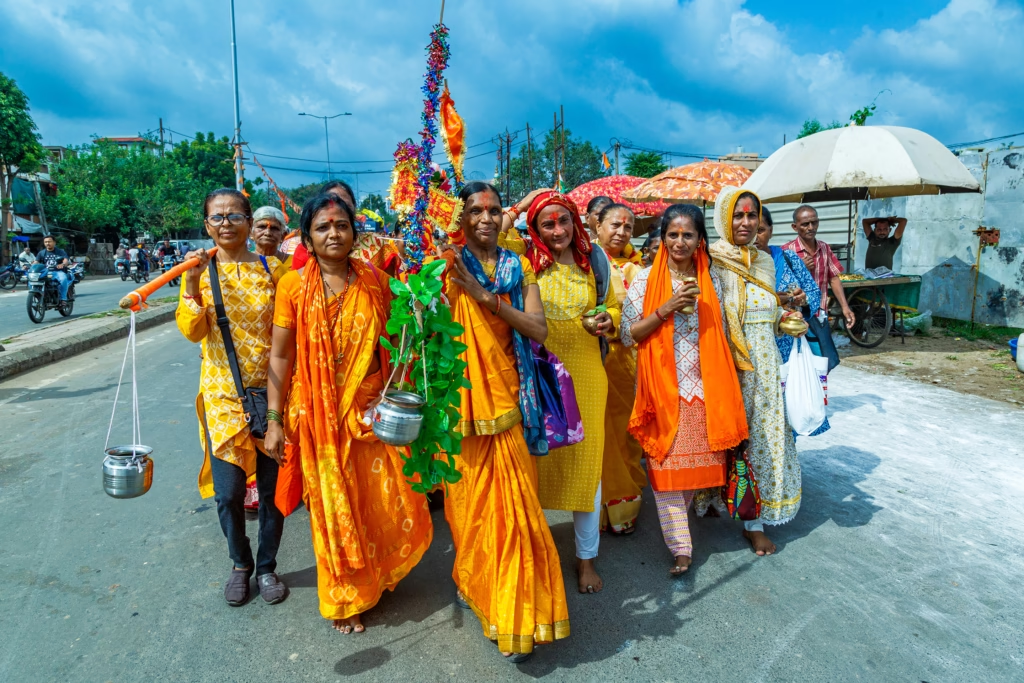Every year, during the monsoon month of Shravan, a sea of saffron moves across India’s highways, forests, and towns. These are not political rallies or protest marches — these are the Kanwariyas, devoted followers of Lord Shiva, carrying holy water from the Ganges in decorated bamboo slings called kanwars.
To the uninitiated, it may seem like just another religious festival. But dig deeper, and you’ll find that Kanwar Yatra is not just a pilgrimage — it’s a test of endurance, a ritual of purification, and a symbolic journey inward.
In this article, we’ll uncover the ancient myths, modern realities, and spiritual secrets of the Kanwar Yatra — many of which even lifelong devotees don’t know.
At first glance, it may look like a religious procession. But Kanwar Yatra is something far deeper — it’s a test of will, a spiritual cleanse, and, for many, a personal rebirth. It’s where ritual meets resilience, and the road becomes a living temple.
📌 Do You Know? 📌
Kanwar Yatra has grown to become the largest annual religious gathering on foot in the world, with over 30 million participants in peak years.
Table of Contents
What Is the Kanwar Yatra? A Sacred Journey Explained
The Kanwar Yatra is an annual pilgrimage observed primarily in North India, where devotees of Lord Shiva — known as Kanwariyas — walk to fetch holy water from the Ganga River and offer it at Shiva temples in their hometowns, especially at Shiva jyotirlingas.
Don’t Know About Jyotirlingas? We’ve got you covered >> Jyotirlingas: 12 Pillars of Light Across Bharat
This act of devotion takes place during the auspicious Shravan month (July-August), believed to be the most spiritually potent time to worship Lord Shiva. While the journey itself may stretch for hundreds of kilometers, Kanwariyas walk it barefoot, often singing bhajans, chanting “Bol Bam!”, and maintaining strict physical discipline.
📌 Do You Know? 📌
The name “Kanwar” comes from the bamboo pole (कांवड़) used to balance pots of Gangajal on either side, symbolizing balance between body and spirit.
Key Components of the Yatra:
- Kanwars: Special slings made of bamboo, cloth, and decorations used to carry Ganga water.
- Pilgrimage Sites: Most Kanwariyas fetch water from Haridwar, Gaumukh, Gangotri, or Sultanganj, depending on their region.
- Destinations: Common temples include Kashi Vishwanath, Baidhyanath Dham (Deoghar), and Neelkanth Mahadev.
- Rules: The kanwar should not touch the ground, and many devotees observe strict fasts and silence.

Ancient Origins — The Mythological Roots of the Kanwar Yatra
The Kanwar Yatra may appear like a recent phenomenon due to its growing visibility, but its roots lie deep in Hindu mythology, going back thousands of years. This sacred journey is intimately tied to Lord Shiva’s cosmic role as the Neelkanth — the blue-throated savior who drank the poison of the universe to protect creation.
The Story of Samudra Manthan: The Birth of the Yatra
According to ancient scriptures, during the churning of the ocean (Samudra Manthan) by the gods (Devas) and demons (Asuras), a deadly poison called Halahala emerged. This poison threatened to destroy all life in the universe.
In a supreme act of selflessness, Lord Shiva drank the poison to save the world. To prevent it from harming him, the poison was held in his throat, turning it blue — thus earning him the name Neelkanth.
To soothe Shiva’s burning throat, devotees began offering him holy water from the Ganga — a sacred river believed to possess cooling and purifying powers. This act of offering water became a symbolic ritual, passed down through the ages, forming the foundation of what we now call the Kanwar Yatra.

🔍 Myth Buster 🔍
While some believe the Kanwar Yatra started only a few decades ago, historical references and folklore suggest it was practiced by sages and commoners alike in medieval and even ancient times. Modern highways may have replaced forest paths, but the intent remains unchanged.
Parshuram: The Warrior Sage Who Walked With Faith
Another fascinating figure tied to the spirit of the Yatra is Parshuram, the sixth incarnation of Lord Vishnu and an ardent devotee of Shiva.
Parshuram is often remembered for his penance and pilgrimages after vanquishing corrupt Kshatriyas. Several legends mention him carrying Ganga water to Shiva temples, walking barefoot as a form of repentance and surrender.
📌 Do You Know? 📌
In many folk versions of the Kanwar Yatra’s history, Parshuram is considered one of the first legendary ‘Kanwariyas’, symbolizing the merging of devotion, discipline, and atonement.
His intense devotion and ritual practices are believed to have influenced how future generations — sages and commoners alike — approached Shiva worship through self-sacrifice and long pilgrimages.
From Myth to Tradition: How It Endures
References to similar rituals are found in Puranic texts like the Skanda Purana, and local folklore across Uttarakhand, Bihar, and Jharkhand. The Yatra was not institutionalized but emerged organically as a living act of devotion — especially among ascetics who wandered with hand-crafted kanwars, seeking purification through their journey.
Even today, this mythologically charged pilgrimage continues to draw millions — not just because of scripture, but because it offers a direct, physical way to connect with the divine.
Some historians believe that Raja Daksha’s story, where Lord Shiva is disrespected during a yajna (sacrifice), also contributed to the culture of making peace offerings through rituals like the Kanwar Yatra.
Symbolism & Spiritual Significance of the Yatra
While the Kanwar Yatra may appear outwardly as a mass religious event, at its core, it is a deeply symbolic spiritual journey. Every aspect of the Yatra — from walking barefoot to wearing saffron—carries layers of ancient meaning, designed not just to please the divine, but to transform the self.
This section explores how the Kanwar Yatra becomes a path of inner purification, making it more than just a pilgrimage.
Why Walk Barefoot? A Sign of Surrender
Walking barefoot is more than a physical challenge — it’s a gesture of humility and surrender. In Hindu dharma, touching the Earth directly with your feet during spiritual practice is believed to ground the ego and enhance energetic connection with the divine.
It also symbolizes renunciation of comfort — a conscious choice to step out of one’s routine and walk for a higher cause.
During a visit to Haridwar in Shravan, I saw a father-son duo walking barefoot in 40°C heat. When asked why they wouldn’t even wear sandals, the father replied, “This journey is not for the body — it’s for the soul.”
Why Saffron Clothes? A Symbol of Sacrifice
Saffron (bhagwa) is the colour of sacrifice and purity in Indian tradition. Saints, sages, and ascetics have worn it for centuries. When Kanwariyas wear saffron, they symbolically shed worldly attachments and temporarily take on the role of a spiritual seeker.
The uniform colour also unites people from all castes, regions, and social classes into one collective identity: devotees of Shiva.
Why Observe Silence or Chant in Groups?
Silence during the Yatra — known as maun vrat — is observed by many as a means of internal reflection. Others engage in group chanting of “Bol Bam!”, invoking Shiva with every step.
Both approaches are forms of spiritual discipline that:
- Channel the mind away from distractions
- Reinforce devotion through repetition
- Create a shared vibration of energy and purpose
Water as a Purifier: Offering the Ego to Shiva
Ganga water isn’t just sacred because it’s holy — it represents purity, clarity, and truth. Carrying it for hundreds of kilometres without letting the pot touch the ground is a metaphor for preserving purity amidst chaos.
When the Kanwariya finally pours the water over the Shiva lingam, it symbolizes a final act of surrender — offering not just water, but the burden of ego, anger, and attachment.

Not Just Faith: Physical, Mental & Social Dimensions
The Kanwar Yatra isn’t just a spiritual ritual — it’s an immersive journey that transforms the body, mind, and community spirit. The sheer act of walking barefoot for hundreds of kilometres is a test of endurance that very few modern experiences offer.
Walking such long distances, often barefoot and fasting, pushes the body beyond comfort. For many, it’s the closest they come to a tapasya (austerity), echoing ancient ascetics. This isn’t just symbolic — it trains the body to detach from material dependence and embrace simplicity.
In a world filled with distractions, the mental discipline of the Yatra is profound. Some Kanwariyas walk in silence; others chant Shiva’s name in rhythmic harmony. Both modes of devotion are meditative in nature, often leading to a clarity of thought rarely experienced in daily life.
📌 Do You Know? 📌
Repeating “Bol Bam” while walking isn’t just an act of devotion — it synchronizes breath and step, creating a rhythm that mimics yogic breathing, enhancing mental calm.
The roadside langars, water stalls, first aid stations, and resting huts are all set up by local people — many of whom aren’t even participating in the Yatra. It becomes a social movement of service, where humanity and hospitality are at the forefront.
Even in the chaos, there’s a powerful sense of collective responsibility. People from different castes, backgrounds, and economic classes walk side by side with a shared purpose. It’s not unusual to see strangers helping each other with shoes, water, or even carrying the kanwar.
Non-Religious Takeaways from the Kanwar Yatra
While the Kanwar Yatra is deeply spiritual, it also offers life lessons that go beyond religion:
- Detox from Digital Life – With phones off and focus inward, many rediscover the joy of offline existence.
- Reconnecting with Nature – Walking through forests, riversides, and villages brings back a connection with the Earth.
- Building Inner Resilience – Facing discomfort voluntarily trains the mind to handle future hardships more gracefully.
- Promoting Unity & Harmony – Shared discomfort builds empathy across barriers of class, language, and religion.
⚖️ Myth Buster ⚖️
While some media portray the Yatra as disruptive, the ground reality in most routes is often peaceful, organized, and filled with mutual respect.
Hidden Rituals & Lesser-Known Facts of the Kanwar Yatra
Beyond the devotion and saffron spectacle lies a web of little-known traditions and unspoken rules that make the Kanwar Yatra one of the most intriguing spiritual movements in India.
Kanwar Sewa Camps: The Unsung Backbone
All along the highways during Shravan month, you’ll find free service camps (called sewa shivirs) offering food, rest, massage, medical aid, and even phone charging — for absolutely no cost.
But who runs them?
Often, these are set up by local shopkeepers, youth groups, truck unions, or individuals who see this act of service as their own offering to Lord Shiva. It’s their way of participating in the Yatra without physically walking.
📌 Do You Know? 📌
Many sewa camps start planning 6–8 months in advance, and some even compete informally to serve the largest number of pilgrims.

The Rule of Purity: Kanwar Must Never Touch the Ground
One of the most sacred rules: the Kanwar (water container) must not touch the ground once filled. Pilgrims build makeshift stands or hold it upright while resting. Dropping it is considered an inauspicious failure of duty.
This rule creates discipline and continuous mindfulness — even during rest.
The Dak Kanwar: A 100+ km Non-Stop Sprint
Some pilgrims take it to an extreme — these are the Dak Kanwariyas. They don’t walk — they run non-stop, sometimes barefoot, for over 100 kilometers without resting or eating.
Their relay-like method is designed to offer the water as fast as possible — out of urgency, devotion, and spiritual intensity.
A Journey That Erases Social Barriers
One of the most beautiful aspects of the Kanwar Yatra is how all hierarchies dissolve during the walk. A CEO and a rickshaw driver might walk side by side, rest at the same camp, and chant the same Bol Bam! cry.
There’s no VIP treatment here — everyone is equal in the eyes of Shiva.
Ever joined a spiritual movement that erased all boundaries? Share your experience in the comments.
Modern Faces of a Traditional Yatra
Though traditionally male-dominated, today’s Kanwar Yatra is seeing a surge of women pilgrims — young girls, mothers, even elderly women walk with equal fervor.
Even foreign travelers, fascinated by the scale and spirit of the Yatra, sometimes join in — walking stretches or volunteering in camps.

Controversies, Crowd Management & Misunderstandings
While the Kanwar Yatra is rooted in ancient devotion and spiritual endurance, it’s not without modern-day controversies and logistical challenges. As the scale of participation has grown — crossing crores of devotees annually — so have debates around public inconvenience, law and order, and the behaviour of a minority of Kanwariyas.
Every year, major highways across North India are blocked or partially closed to create dedicated lanes for Kanwariyas. While this ensures their safety, it often leads to traffic congestion and daily disruption for commuters.
⚖️ Myth Buster ⚖️
Contrary to belief, not all Kanwariyas engage in disruptive behaviour. In fact, a majority follow the rules of the yatra peacefully. It’s often a few miscreants — sometimes non-devotees in disguise — who create chaos and bring a bad name to the entire pilgrimage.
Given the sheer volume of pilgrims, state governments deploy thousands of police personnel, drones, and CCTV monitoring. Temporary medical tents, water stations, and disaster-response units are placed along major routes.
Still, stampedes and occasional violence have been reported in the past — mostly due to overcrowding, mismanagement, or rule violations.
📌 Do You Know? 📌
In 2022, district authorities in places like Amroha, Uttar Pradesh, operated a Kanwar Yatra Helpline Control Room to assist pilgrims with lost persons, health emergencies, or route information — via direct phone lines.
The rise of videos showing aggressive Kanwariyas damaging vehicles or clashing with authorities has painted an unfair image in the public mind.
But this highlights the need for awareness on both sides: the public should be mindful of the sanctity of the ritual, and devotees must embody the core values of Shiva — compassion, calm, and detachment.
Why the Yatra Still Matters in 2025 — A Personal and National Reflection
In a rapidly modernizing India, it’s easy to dismiss age-old traditions like the Kanwar Yatra as outdated or chaotic. But this pilgrimage, beyond its religious fervour, serves as a mirror — reflecting who we are as a society, what we value, and where we find meaning.
For many young Indians, the Yatra has become a form of spiritual rebellion — a conscious return to roots in an era of digital distractions. The walk offers something rare: stillness in motion, a meditative pause amidst noise, and a reset for both mind and body.
Nationally, the Kanwar Yatra continues to uphold the idea of Bharat — where caste, status, and background dissolve as people walk shoulder to shoulder for something larger than themselves. In a time of division, it’s a reminder of unity born from shared devotion, service, and sweat.
As India balances tradition with technology, rituals like the Kanwar Yatra are not just being preserved — they’re being reinterpreted. Women, youth, and even international seekers are joining the journey, showing that ancient spirituality still holds modern relevance.
Inspired by the Kanwar Yatra?
Here’s What You Can Do Next:
Whether you’re a spiritual seeker, a culture enthusiast, or simply curious about Bharat’s living traditions, the Kanwar Yatra offers timeless lessons in discipline, unity, and devotion.
Don’t let it end here.
Share this article with someone who still sees it as “just a ritual.”
Explore more spiritual journeys on Whispers of Bharat — your gateway to the deeper truths of Indian culture.
Subscribe to our newsletter for weekly insights, lost legends, and sacred secrets that don’t make it to textbooks.
🔔 Join the Yatra of Awareness. Rediscover the Bharat within. 🔔
FAQs – Frequently Asked Questions
What is the Kanwar Yatra and why is it important?
The Kanwar Yatra is an annual pilgrimage where devotees of Lord Shiva, called Kanwariyas, carry sacred water from the Ganga river to offer at Shiva temples, especially during the month of Shravan (July–August). It symbolizes devotion, penance, and surrender.
When does the Kanwar Yatra take place in 2025?
In 2025, the Kanwar Yatra is began on 11th July and peaked around Shravan Shivratri and ended by 23rd July.
Who participates in the Yatra? Is it only for men?
While the majority of Kanwariyas are young men, in recent years many women and even foreigners have begun to take part. The Yatra is open to anyone who wishes to show devotion to Lord Shiva.
Why do Kanwariyas wear orange clothes?
Orange is the sacred colour of renunciation and devotion in Hinduism. Kanwariyas wear saffron to symbolize purity, sacrifice, and their commitment to Lord Shiva.
What is the significance of not letting the Kanwar touch the ground?
The Kanwar (a bamboo pole with water containers) is considered sacred. Allowing it to touch the ground is seen as disrespectful. Devotees either hang it on a stand or take turns carrying it, even during rest breaks.
What is ‘Dak Kanwar’?
‘Dak Kanwar’ refers to a special group of devotees who run non-stop from the Ganga river to their destination temple without resting. It is considered the most intense and pure form of devotion.
Are there rules Kanwariyas must follow during the Yatra?
Yes. Devotees usually follow strict rules of purity — avoiding meat, alcohol, and certain behaviors. Many also maintain celibacy and avoid anger or foul language during the Yatra.
Are there free services available during the Yatra?
Absolutely. Thousands of Kanwar Sewa Camps are set up by local communities, volunteers, and spiritual organizations. These camps offer free food, water, medical aid, and places to rest.
Has the government taken steps for crowd control and safety?
Yes. In states like Uttar Pradesh, the government has launched Kanwar Helplines, mobile tracking apps, drone monitoring, and traffic control systems to ensure smooth movement and quick emergency response.
Is the Kanwar Yatra only a religious event?
While deeply spiritual, the Yatra also represents social equality, community service, and national identity. It brings together people across class and caste lines, often sparking personal transformation.

